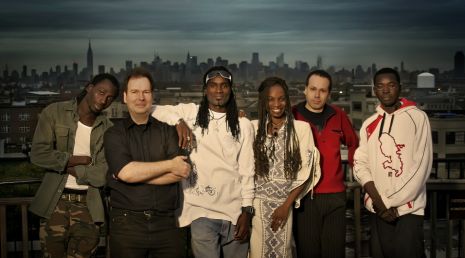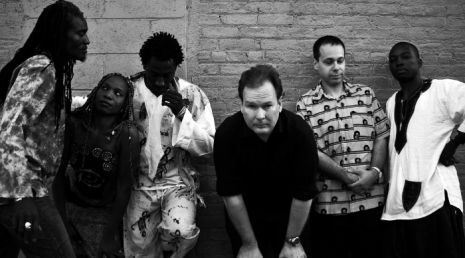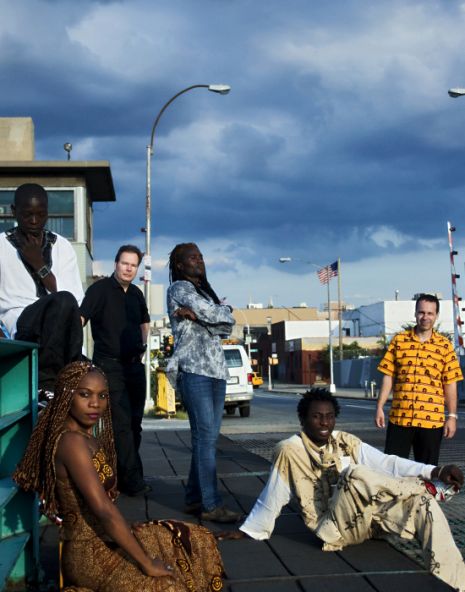Formation
During my college days in Vienna, around 1987, I happened upon African music through a variety of coincidences. My father was listening to certain traditional musics from Africa at the time, and we often swapped cassettes. I dabbled in musicology for a while (giving it up because I didn't have enough time to study both composition and drums plus musicology) and the great ethnomusicologist Gerhard Kubik gave lectures, which I often attended.
Reading Kubik's articles about the traditional court music of the Kingdom of Buganda (in Uganda) was a major turning point for me. In this music, ensemble members play together in exact coordination, yet do not feel the beat as occurring simultaneously. This relative view of the beat was a new idea to me; it is unknown in Western music, and I wondered if it might be possible to use this approach in my compositions, in order to find new way of metric interplay between musicians in an ensemble.
I discovered there was a classical percussion quartet in Budapest called the Amadinda Percussion Group, which was remarkable as the amadinda is one of the instruments used in the music of Buganda. They had learned about this little-known tradition, mastering the art of interplay with a relative beat, and soon became champions of my piece. It remains in their repertoire and several other percussion groups have played it as well.
In 1992, I was in Amsterdam and visited STEIM, the electronic music research center. There, a programmer, Frank Baldé, showed me "Polyrhythm", a program he had just written for the Den Haag Percussion Group, who was having trouble maintaining coordination while rehearsing music by Iannis Xenakis. It was a very basic sequencer, running on Atari computers, that allowed one to program simple metronome tracks, but in any rhythm or meter one desired - say 14th notes in 18/19 time at tempo 159.23.
I thought it might be interesting to use the possibilities of this program to compose a piece that could not be played without it. I had just received my first commission, for a large mixed chamber ensemble. I devised a setup whereby 11 musicians each had seemingly independent metronomic tracks, relayed via headphones and centrally coordinated by a computer; that way, I was able not only to use the idea of a relative beat as it is known in Uganda but to take things much further by having the 11 musicians play at 11 different tempi, or by composing a crazy hocket with the 11 players alternate at lightning speed. The piece, "Groove Magic", was premiered in 1993 by the London Sinfonietta.
While African music had served as the initial inspiration for all this, "Groove Magic" itself had little to do with African music.
I began in 1988 by developing a polymetric drumset playing technique for myself and writing a marimba quartet, "Pattern Transformation", which, upon completion, I deemed unplayable: African musicians wouldn't be able to play it because they are not trained to read music, and Western ones wouldn't be able to play it because they are not trained in this method of interplay.
Around the time I wrote “Groove Magic,” the Goethe Institute was looking for an African-inspired musician to send to Côte d'Ivoire for an exchange with West African traditional musicians. Under their auspices, in 1994, I made my first trip to Africa, for a two-week stay in Abidjan. This proved to be just as life-changing an experience as my first contact with African music through the work of Gerhard Kubik, and after 2 weeks, I somehow had my own band, Beta Foly. I continue to work with some of these musicians today.
This initial trip to Côte d'Ivoire was my first contact with certain types of West African music, especially that of the Mandé people, which had an immediate, profound emotional effect on me and became perhaps the greatest influence on my melodic imagination.
My basic premise for the exchange in Abidjan was that I didn't know how to play West African music, and these musicians didn't know how to play my music, so we had better figure out something else to do, something new that could not exist without the input of our diverse backgrounds. I pushed us not to just jam but to work together in an experimental way, and brought my headphone setup with me, also using electronic percussion, which I had just started playing.
The musicians came from all over West Africa and had to work to understand how to communicate musically with one another. I began asking questions, much like a musicologist would, and asked them to do things that, for some reason, they did not do. For example, there were two balafon (traditional marimba) players with differently-tuned balafons who never played at the same time because they said their different tunings were incompatible. I asked them to play together and see what would happen, forcing outselves to find something new as a result of that incompatibility.
I continue to explore traditional musics yet have never wanted to learn a tradition perfectly, but rather to understand how the music is conceived and what is important when it is played, using these insights as an inspiration for the development of my own ideas. Spending time in Africa has shown me that the progression from traditional music to pop is a very gradual one, with no clear boundaries between them. While I support the idea of preservation, as many musicologists do, my principal interest is in innovation and in contemporary manifestations of these musics, including urban pop as well as in traditional forms.






